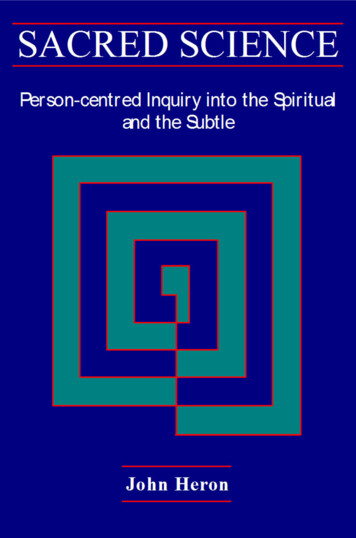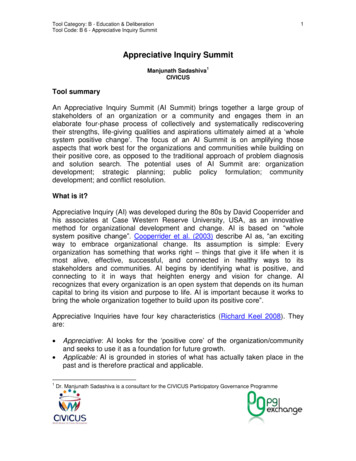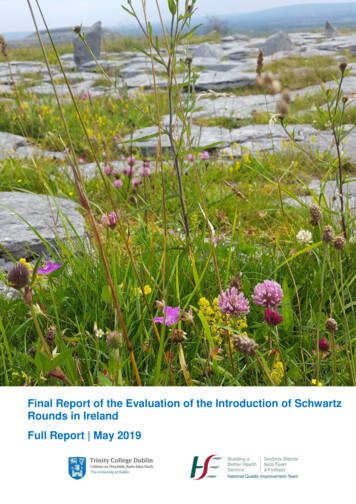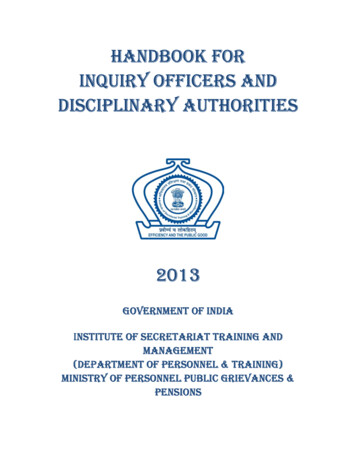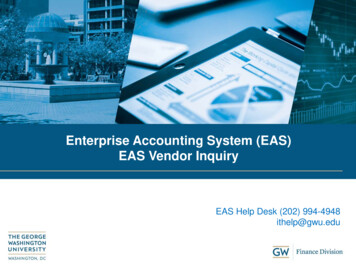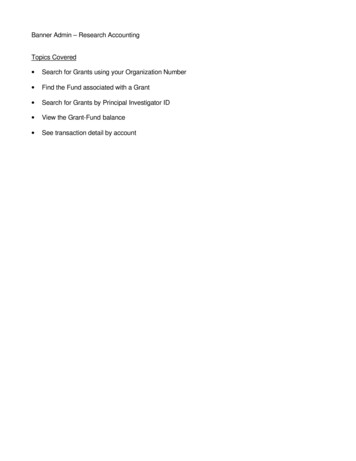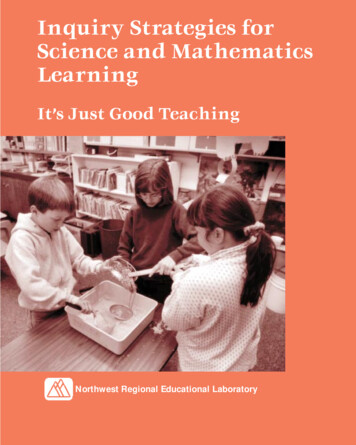
Transcription
Inquiry Strategies forScience and MathematicsLearningIt’s Just Good TeachingNorthwest Regional Educational Laboratory
This publication is based on work supported wholly or in part both by agrant and contract number RJ96006501 from the U.S. Department ofEducation. The content of this document does not necessarily reflect theviews of the department or any other agency of the United Statesgovernment. Permission to reproduce this publication in whole or in partis granted with the acknowledgment of the Northwest RegionalEducational Laboratory as the source on all copies.Comments or queries may be directed to Kit Peixotto, Unit Manager,Science and Mathematics Education, Northwest Regional EducationalLaboratory, 101 S.W. Main Street, Suite 500, Portland, Oregon 97204,(503) 275-9594 or (800) 547-6339 ext. 594.Appreciation is extended to the many educators who providedinformation and guidance in the development of this publication.Acknowledgments also go to the panel of reviewers and contributors fortheir valuable input: Peggy Cowan, Norie Dimeo-Ediger, John Graves, RexHagans, Berk Moss, Rosalind Philips, Jennifer Stepanek, WalterWoolbaugh, and Shirley Wright. In addition, several individuals madespecial contributions to the development of this product, including:Denise Jarrett—Research and writingKit Peixotto—Conceptual support and guidanceDawn Dzubay—Resource research and compilationDenise Crabtree—Desktop publishingLee Sherman—Editorial reviewPhotography—Denise Jarrett: front and back covers, pages 3, 6, 7, 9, 12, 16, 17,18, 23, 26; Rick Stier: pages 4, 11, 15, 20, 21, 25; Tony Kneidek: page 24
Inquiry Strategies forScience and MathematicsLearningIt’s Just Good Teachingby Denise JarrettScience and Mathematics EducationMay 1997Northwest Regional Educational Laboratory
Table of ContentsPreface.1Introduction.2What is inquiry? .3Inquiry is on a continuum.3Inquiry is “just good teaching” .5Why use inquiry? .5Improves student attitude and achievement.5Facilitates student understanding.6Facilitates mathematical discovery .7Inquiring into pendulums in Manhattan, Montana.8Creating an inquiry-based classroom.7Engage students in designing the learning environment.11Reflect the nature of inquiry .11Integrate science laboratories into the regular class day.11Use inquiry in the mathematics classroom .12Use management strategies to facilitate inquiry.12Share control .13Spark student motivation .13Take on new roles.14Implications for curriculum.15Teaching the “facts”.16Choosing an inquiry topic .17Getting at the core content .18Planning an inquiry lesson.19Using the Learning Cycle Strategy.19Planning the use of time.20Presenting the inquiry topic.21Classroom discourse and questioning.22Classroom discourse .22Questioning .23Asking probing questions .23Divergent questions and comments.24Challenges of inquiry-based teaching .25Demands on teacher content knowledge .25Demands on pedagogical skill .26Conclusion .26Resources and bibliography.27
Prefacemathematics and science knowledge,skills, and abilities necessary for success.Inquiry-based teaching is a perfectcomplement to a child’s naturalcuriosity about the world and how itworks. Whether it is the elementary student’s wonder that is prompted by astory about hibernating animals, themiddle school student’s predictions aboutthe relationship between circumferenceand diameter that arise from an exploration of different-sized spheres, or thehigh school student’s questions that areprovoked by a local environmental issue,students become actively engaged in thelearning process when given the opportunity to hypothesize and investigate.The Northwest Regional EducationalLaboratory is committed to improve educational results for children, youth, andadults by providing research and development assistance in delivering equitable, high-quality educational programs. We are proud to be partners withthe dedicated practitioners who work onbehalf of students throughout theNorthwest. We invite your analysis andfeedback of Inquiry Strategies for Scienceand Mathematics Learning: It’s Just GoodTeaching as a resource to strengthen science and mathematics education in theregion.The Science and Mathematics Educationunit at the Northwest Regional Educational Laboratory offers Inquiry Strategies for Science and Mathematics Learning as the second publication in our It’sJust Good Teaching series. Intended tofurnish K-12 teachers with bothresearch-based rationale and recommendations for effective techniques that canbe applied in today’s complex andchanging classrooms, future topics inthe series will explore standards-basedteaching and using assessment to informinstruction.Kit PeixottoUnit ManagerScience and Mathematics EducationMay 1997All publications follow a similar format.An initial summary of the key themesin the current research and literaturesets the stage for the subsequent discussion of research-recommended practices.Included throughout the publicationsare insights from Northwest educatorswho are implementing these strategiesand represent examples of “real-liferesearch in practice.” The listing of printmaterials, organizations, and onlineresources enables teachers to access andexplore additional tools to support theirefforts to provide all students with the1
Introductionown ideas and to pursue their own investigations (NRC, 1996; NCTM, 1991; AAAS,1990, 1993). However, no single teachingmethod is appropriate in all situations,for all students. Teachers need to knowhow and when to use a variety of strategies (Good & Brophy, 1997). Embeddingteaching strategies within an overallinquiry-based pedagogy can be an effective way to boost student performance inacademics, critical thinking, and problem solving.In the past 20 years, our understanding of how people learn has changeddramatically. Not long ago, educatorsand psychologists believed that students’brains were like empty vessels waiting tobe filled with knowledge imparted by ateacher. But advances in cognitiveresearch and developmental psychology,combined with today’s urgency to educate all students in an increasinglydiverse and technological society, havetransformed the way we think aboutteaching mathematics and science(Brown & Campione, 1994; Rosenshine,1995; Roth, 1993; Nowell, 1992; Ornstein,1995).Today, educators and researchers understand that most people learn bestthrough personal experience and by connecting new information to what theyalready believe or know (NationalResearch Council [NRC], 1996; AmericanAssociation for the Advancement of Science [AAAS], 1993). Excellent teachingand quality textbooks aren’t enough.Students need to personally constructtheir own knowledge by posing questions, planning investigations, conducting their own experiments, and analyzing and communicating their findings.Also, students need to have opportunitiesto progress from concrete to abstractideas, rethink their hypotheses, andretry experiments and problems (NRC,1996; AAAS, 1990, 1993; National Councilof Teachers of Mathematics [NCTM], 1991;Rosenshine, 1995; Flick, 1995). In short,students construct their own knowledgeby actively taking charge of their learning—one of the primary tenets ofinquiry.An inquiry-based classroom is morethan a “gathering of individual learnersbrought together for reasons of economy.” Rather, it is a “community ofinquiry” (Schifter, 1996). In this community, students and teachers share responsibility for learning, and collaborate onconstructing new knowledge. Students“INQUIRY IS THE [SET] OFBEHAVIORS INVOLVED INTHE STRUGGLE OF HUMAN BEINGS FORREASONABLE EXPLANATIONS OFPHENOMENA ABOUT WHICH THEY ARECURIOUS.”have significant input into just aboutevery aspect of their learning—how theirclassroom is set up, how time is structured, which resources are used, whichtopics are explored, how investigationswill proceed, and how findings arereported. No longer are teachers the solepurveyors of knowledge and studentspassive receptacles.Science and mathematics reform standards call for inquiry teaching methodsthat enable students to contribute their2
What is inquiry?structured hands-on activities and “cookbook” experiments; in the middle mightbe guided inquiry or the use of sciencekits; and, at the farthest end, studentsmight be generating their own questionsand investigations. A teacher’s goalshould be to strive for the farthest end ofthe continuum where students areinvolved in full inquiry. There are timeswhen she will find it necessary toemploy lower-level inquiry strategies tomeet specific goals. However, a teachershould not assume that a structuredhands-on activity will necessarily haveall of the elements of inquiry.Scientific inquiry is more complexthan the traditional notion of it.Rather than a systematic method ofmaking observations and then organizing them, scientific inquiry is a subtle,flexible, and demanding process, statesthe Benchmarks for Science Literacy(AAAS, 1993).From a science perspective, inquiry oriented instruction engages students inthe investigative nature of science, saysDavid L. Haury in his article, TeachingScience through Inquiry (1993). Haurycites scientist Alfred Novak’s definition:“Inquiry is the [set] of behaviorsinvolved in the struggle of humanbeings for reasonable explanations ofphenomena about which they are curious.” In other words, inquiry involvesactivities and skills that focus on theactive search for knowledge or understanding to satisfy a curiosity, saysHaury.Inquiry is also central to mathematics.Today, mathematics education encompasses more than arithmetic and algorithms. It is a diverse discipline thatinvolves data, measurements, and recognition of patterns (NRC, 1989). “Theprocess of ‘doing’ mathematics is farmore than just calculation or deduction;it involves observation of patterns, testing of conjectures, and estimation ofresults,” states the National ResearchCouncil in Everybody Counts, a report tothe nation on the future of mathematicseducation (1989). “Mathematics revealshidden patterns that help us understandthe world around us.”When choosing from the continuum,teachers will need to consider a numberof variables such as their own teachingskills; student readiness, maturity, andability; and pedagogical goals. Occasionally, the teacher will move back andforth on the inquiry continuum to meetcertain goals and circumstances. BerkMoss, science curriculum coordinator forthe Beaverton School District in Oregon,provides an example of how a teacher’sprogression toward full inquiry mightproceed:Inquiry is on a continuum. Inpractice, inquiry often occurs on a continuum. On one end of the continuumof inquiry might be the use of highly3
Students answer questions generatedby the teacher from open-ended laboratory activities Students answer questions of their ownfrom open-ended laboratory activities“Each step represents significantly morerisk taken by the teacher and increasingly complex classroom management,”says Moss. “I celebrate each move alongthe continuum.”“It is quite reasonable to supply some ofthe inquiry steps to students so that theycan focus their learning on other steps,”says Moss. “For example, we might supply the question and ask them to devisethe investigation or give data and askthem to analyze and test a givenhypothesis. The complexity of theseactivities will vary with student age andexperience, but there are entrances forevery child.”Students can do investigations requiringdata collection that don’t require complex laboratory preparation by theteacher, says Moss. “All inquiry experiences do not need to involve a mop andapology to the custodian.”Students engaged in full inquiry aredoing the following, says Moss: Learning in a rich environment Activities focus on textbooks, libraryreports, and worksheets Thinking of a question, and shaping itinto something they can investigate Demonstrations are done for students Hypothesizing Students conduct “cookbook experiments” (student replications, notdiscoveries) Planning an investigation Collecting data Students do laboratory activities thatlead to student discoveries Analyzing that data4
They use skillful questioning to focusstudent engagement and to probe formisunderstandings. They provide clearand appropriate explanations. They useconcrete examples and analogies—relevant to students’ lives—to illustrateabstract concepts and to facilitate understanding. They anticipate areas of content that are likely to give students problems, and they conclude lessons by highlighting the main points (Tobin & Fraser, 1991). Forming a conclusion Communicating their findingsInquiry is “just good teaching.”Research has identified effective teaching strategies, many of which are coreelements of inquiry. In the book Effective Teaching: Current Research (Waxman & Walberg, 1991), Kenneth Tobinand Barry Fraser identify teachingstrategies that are used by exemplarymathematics and science teachers.According to research, exemplary teachers ensure that activities are set up toallow students to be physically andmentally involved in the academic subjects. Activities are based on the use ofmaterials to investigate questions andsolve problems. Teachers use verbalinteraction to monitor student understanding of the content, and facilitatepeer interactions by setting up smallgroup discussions.Why use inquiry?There is evidence that inquirybased instruction enhances student performance and attitudesabout science and mathematics, saysDavid Haury (1993). At the middle schoollevel, students who participate ininquiry-based programs develop betterlaboratory and graphing skills, and learnto interpret data more effectively, hesays. He points to research that indicatesinquiry-based programs foster scientificliteracy and understanding of scientificprocesses; vocabulary knowledge andconceptual understanding; criticalthinking; positive attitudes; higherachievement on tests of proceduralknowledge; and construction of mathematical knowledge.“ALL INQUIRYEXPERIENCES DONOT NEED TO INVOLVE A MOP ANDAPOLOGY TO THE CUSTODIAN.”Improves student attitude andachievement. According to EducationAt all levels, teachers are effective in arange of verbal strategies which includeasking questions to stimulate thinking;probing student responses for clarification and elaboration; and providingexplanations to students, say Tobin andFraser. The most successful teachershave deep content knowledge in the subject areas that they teach, and in the relevant pedagogical theories and strategies.Week (Lawton, 1997), a poll by Bayer Corporation of Pittsburgh showed that students who used hands-on experimentsand team problem solving in scienceclassrooms have a better attitude aboutthe subject than students who learnedscience through lectures and assignedtextbook reading. Three out of five students, ages 10 to 17, said that they would5
level reasoning skills, and had more positive attitudes about physics than thosetaught by more traditional methods(University of Northern Iowa, 1997).Facilitates student understanding. Students develop critical thinkingskills by learning through inquiry activities. They learn to work collaboratively,to articulate their own ideas, and torespect the opinions and expertise ofothers. They learn inquiry skills thatthey can use in other aspects of theirlives and intellectual pursuits.Building on John Dewey’s premise thatstudents need to be engaged in a questfor learning and new knowledge, andJean Piaget’s statement that, “Experienceis always necessary for intellectual development; (therefore) the subject must beactive,” researchers in the past twodecades have developed a new understanding of learning (Brown & Campione, 1994; Rosenshine, 1995; Roth, 1993;Nowell, 1992). Constructivist theory statesthat knowledge is constructed throughone’s personal experience by assimilating new information with prior knowledge (King & Rosenshine, 1993).be “a lot more psyched” about science ifthey could do more experiments themselves and use a computer to communicate with scientists and other students.Fifty-four percent of the students usingmore inquiry-oriented methods said thatscience is one of their favorite subjects,compared with 45 percent of the students in traditionally taught classes.Also, nearly 25 percent of the students intraditional classes said that science istheir most difficult subject, while only18 percent of the students using inquirystrategies said so.This theory has shifted researchers’ perspective on knowledge, learning, andteaching, says Raffaella Borasi in herbook, Learning Mathematics ThroughInquiry (1992). Borasi is an associate professor at the Graduate School of Education and Human Development at theUniversity of Rochester and has writtenextensively on mathematics and inquiry.Knowledge is viewed not as a stable bodyof established results, she says, but as adynamic process of inquiry, where“uncertainty, conflict, and doubt providethe motivation for the continuous searchfor a more refined understanding of theworld.” In this view, learning is a generative process of meaning making that isThe College of Natural Sciences at theUniversity of Iowa (1997) administers aproject called Physics Resources andInstructional Strategies for MotivatingStudents (PRISMS). The project blendssuch inquiry-based strategies asexploratory activities, concept development, and application activities into alearning cycle. The college compared theacademic achievement of students whoparticipated in the PRISMS project withstudents who did not. The studiesshowed that the PRISMS studentsachieved at a higher level, used higher6
Facilitates mathematical discovery. As the Benchmarks for Sciencepersonally constructed and enhanced bysocial interactions, she says. Teaching isviewed as facilitating students’ ownsearch for understanding by creating arich learning environment that stimulates student inquiry.Literacy (AAAS, 1993) points out, the roleof inquiry in the study of mathematicsis just as central as it is in science.“It is the union of science, mathematics,and technology that forms the scientificendeavor and that makes it so successful,” states the Benchmarks. “Althougheach of these human enterprises has acharacter and history of its own, each isdependent on and reinforces the others It is essential to keep in mind that mathematical discovery is no more the resultof some rigid set of steps than is discovery of science.”Learning is also a social process (AAAS,1990; King & Rosenshine, 1993; Magnusson & Palincsar, 1995). Students need tointeract with their peers and the teacheron inquiry-based investigations. Theyneed ample opportunities to discusstheir own ideas; confer and debate withtheir classmates; then to have time toreflect on the feedback they’ve received,According to standards written by theNational Council of Teachers of Mathematics, inquiry is one of the most important contexts in which students learnmathematical concepts and knowledge:by exploring, conjecturing, reasoninglogically, and evaluating whether something makes sense or not. During discourse, students develop ideas andknowledge collaboratively, while theteacher initiates and orchestrates discussion to foster student learning. This collaboration “models mathematics as it isconstructed by human beings: within anintellectual community” (NCTM, 1991).to make adjustments, and to retry theirexperiment or activity. They need tohave experiences with the kinds ofthought and action that are typical ofscientists, mathematicians, and technology professionals (AAAS, 1990). In short,students need to understand science,mathematics, and technology as ways ofthinking and doing, as well as bodies ofknowledge (AAAS, 1990).Creating an inquirybased classroomTeachers should design and manage learning environments thatprovide students with the time,space, resources, and safety needed forlearning. Opportunities for active learning and access to a rich array of tools7
Inquiring intopendulums inManhattan, Montanapendulum makes in one second. AsBrenda readies the stopwatch, Woolbaugh pulls the weight back, andreleases it.Brenda calls out, “Stop!” and Woolbaugh grabs the weight in mid-swing.AMay blizzard has thrown aheavy blanket of snow overManhattan, a small farmingcommunity 25 miles west of Bozeman,Montana. This morning, the sun isedging out the storm clouds, and theBridger Range mountains are again inview.“Okay, we had this problem yesterday,”says Woolbaugh. “What’s the problemwith this method?”The students conclude that one second isn’t long enough to measure thefull swing of the pendulum. They suggest timing the swings for at least 15seconds in order to capture a fullswing and to collect enough data toaccurately calculate the measurement.Woolbaugh accepts their strategy,then introduces a new problem, setting the stage for the next activity.Inside Manhattan Middle School, seventh-grade students are settling intotheir chairs in Mr. Walter Woolbaugh’sscience room. A chess game is concluded. The motion machine is given atap, and the caged tarantulas aregiven a peek. At the back of the room,behind the laboratory stations, thedoves coo in anticipation.“Remember, good science starts witha problem,” he says. “Here’s the problem that I want you to address over thenext three days: What affects the period of a pendulum? Is there anythingthat would make the number ofswings per second change? Or is italways the same? That’s what you andyour lab partner are going to solve.”It’s near the end of the school year. Sofar, these seventh-graders have studied geologic processes, and plant andanimal life. Now, they are learningabout mechanical energy. At the frontof the classroom, a long string hangsfrom the ceiling with a bronze weighttied to its end. On the chalkboard iswritten a question: What affects theperiod of a pendulum?Before the students break into smallgroups, Woolbaugh leads them in abrainstorming session. He writes theirideas about what might influence theswing of a pendulum on the chalkboard.Mr. Woolbaugh steps forward.“Okay, what kinds of things did we talkabout yesterday?” he asks. The classreviews yesterday’s introductory lesson about potential and kinetic energy,and the vocabulary term, the period ofa pendulum.“Air pressure,” suggests Tony.“Okay, if we did this experiment onanother planet, or someplace that hadmore air pressure, that might changeit,” agrees Woolbaugh, “but that’s aWoolbaugh repeats a demonstrationfor determining how many swings a8
“String might matter. Okay, good idea.I don’t have a lot of different stringwidths, so that’s not a variable thateveryone will be able to test, but if youwant to try it, Matt, after you test theother variables, that would be an interesting experiment to do.”variable that’s going to be hard for usto control.”“Length of string,” offers Daniel.“Okay, that’s a good one. Would a really short string have a short or fast period? Any discussion about the length ofstring before I go on?” He waits a fewseconds before continuing, “Are thereothers?”Another student says, “Aerodynamicscould make a difference.”“What do you mean by that?” probesWoolbaugh.“How heavy the weight is,” saysMelinda.“It could increase the drag on the pendulum.”“Excellent idea,” says Woolbaugh. “Ilike that one. The weight, yeah! Woulda real heavy weight make a slowerperiod or would it make a faster period? How could we test that?”“Okay, that would be good to test, too.”“What about friction at the top of thestring, where the string is attached tothe wire on the ceiling?” asks Brenda.“Try different weights,” says Greg.“Good. Friction at the point where thestring meets the wire.”The students move into small groupsto set up their own experiments onpendulums. Immediately, they startsearching through drawers, shelves,closets, and cabinets for materialswith which to conduct their investigations: string, wire, weights of all sorts.They are familiar with this routine; onlyoccasionally does Woolbaugh preparematerials for them in advance. Withmaterials in hand, they search aroundthe room for interesting places to fasten their pendulum: ceiling hooks,faucets, and laboratory stanchions.Everything from bronze weights to apair of scissors serves as the pendulum weight.“Right!” Woolbaugh is clearly pleased,but he presses for more ideas. “Otherhypotheses about the period of thependulum?”Members of each group take turnsmanipulating their pendulum, timingits swings, and recording data. After“The diameter of the string mightaffect it,” says Matthew.9
a pendulum; we did a few tests ofeach variable, collected and averageddata; and then drew some conclusionsbased on that data,” he says.“Although our findings aren’t conclusive, we’ve generated some testablehypotheses. Tomorrow, we’re going toretry our experiments. We want to testeach variable a number of times sothat we have enough data to be confident of the accuracy of our measurements.”25 minutes, they return to their desksto report the data they have collected.As it turns out, the students haveexperimented with only two variables:length of string and the weight.“Looking at the data, what do youthink?” asks Woolbaugh. “Give mesome hypotheses.”“I don’t think weight affects it a lot,”says Melinda, wrinkling her brow.“Why do you say that?” asks Woolbaugh.Trina raises her hand, and asks, “Whatif you were to hang the weight fromtwo strings attached to the ceiling, likea swing?”“Because the results for each trial areabout the same.”“Yes, the periods were almost exactlythe same, although we changed theweight in all three trials. Maybe you’reright, maybe the weight doesn’t makethe pendulum swing any faster orslower,” says Woolbaugh. “How aboutlength of string?”“Good one! Nobody’s ever suggestedthat variable,” says Woolbaugh. “Whydon’t you try that tomorrow?”Trina smiles and collects her books asthe school bell rings. The next class ofstudents is already pouring in thedoorway as Trina and the others leaveMr. Woolbaugh’s classroom, untiltomorrow.“The shorter the string, the faster theperiod,” says Jennifer.“It appears that way, doesn’t it?” saysWoolbaugh. “As we get the stringshorter, it appears to go faster. Doesthat mean it’s true? We can’t be sure,because only one test was done oneach variable. Tomorrow, when werepeat our experiments, we’ll need totest each length of string four or fivetimes. This will give us enough datapoints to reach a more accurate average for calculating the period of thependulum.”Woolbaugh reviews the day’s activity.“Today, we followed the scientificprocess—we brainstormed ideasabout what might affect the period of10
goals, planning activities, assessing work,and designing the environment (NRC,1996).and resources are critical to students’ability to do inquiry (NRC, 1996).Engage students in designingthe learning environment. Ask Nurture collaboration among students,and give them significant responsibilityfor the learning of everyone in the community (NRC, 1996). Foster communalsharing of knowledge (Brown & Campione, 1994).students for their ideas and suggestionson such decisions as how to use time andspace in the classroom. This is part ofchallenging students to take responsibility for their learning. Also, as studentspursue their inquiries, they need accessto resources and a voice in determiningwhat is needed. Students often identifyexcellent out-of-school resources. Themore independently students can g
the Benchmarks for Science Literacy (AAAS, 1993). From a science perspective, inquiry ori-ented instruction engages students in the investigative nature of science, says David L. Haury in his article, Teaching Science through Inquiry (1993). Haury cites scientist Alfred Novak's definition: "Inquiry is the [set] of behaviors

